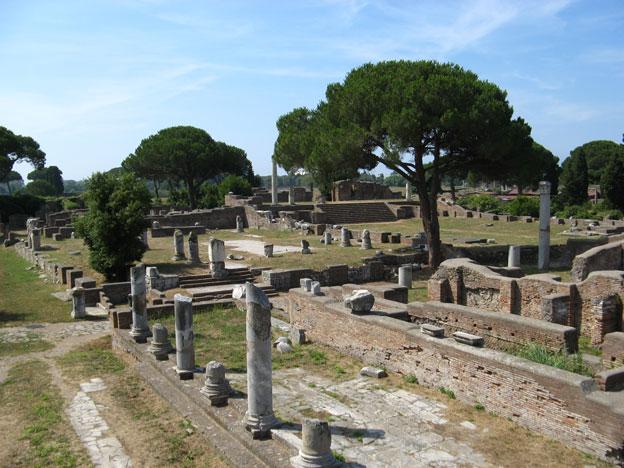Our sandals stumbled over the 2000-year-old stones as we made our way down the mile-long Decumanus Maximus. My husband and I had set out to investigate Ostia Antica: the other Pompeii.
Ostia has less crowds, is cheaper and much closer to Rome than Pompeii. (2 euro each way by bus/train from central Rome). After arriving at the Ostia Metro station, we strolled the few blocks to the entrance.
The mile-long Decumanus, the Roman equivalent of a “main drag,” is paved with dinner-plate sized stones. The thinking was rainwater would drain off and the sandaled foot would stay dry. It was not hard to conjure up images of other pedestrians centuries ago. This had been a thriving town of around 75,000 people.
There are no modern houses, roads or telephone wires visible on the horizon. It gave us the feeling of really being, one with antiquity. The only sound was the breeze coming through the fluffy tops of the Roman pines. A jet did fly over: we immediately ignored it.

The Italian government has done a great job of informing visitors with strategically placed information sites. We also liked the fact that they give you the freedom to discover Ostia on your own. We wandered off the Decumanus, and onto narrow paths scattered with pine needles. We ducked under archways and poked around alleys and back yards.
The early Romans believed that the dead should be buried outside the city, to avoid contamination. After seeing the stone sarcophagi, it’s hard to believe that any infection could penetrate the covering. Not only did they house the dead, but the sculpturing on the outside were works of art.
Just to our right was the Baths of Neptune, a gathering place for the locals. The amazingly preserved mosaic, measuring 55 feet by 36 feet, is of a sea god riding a chariot drawn by four pawing horses.

The elite lived in one-story homes where all rooms led into a central courtyard. Hot running water, which also fed the baths, was channeled through lead pipes in the wall. The less wealthy lived in multi-storied (up to five floors) dwellings. Many of these are in tact and still show the arched doorways and second floor balconies. For an excellent taste of what life was like, (and my favorite) was, the Insula of the Thermopolium (sale of hot drinks) the local tavern where the workers of the day indulged in the local brew. What is amazing is the almost perfect condition of the shelves… earthenware jugs, not glass bottles, reigned here. There were even remnants of a sink and a few glimpses of a wall painting.
We were beginning to get a picture of locals sitting in baths and then, walking down the Maximus to throw back a few at the Insula of the Thermopolium. The Forum of the Corporations, which housed the offices of sixty-four maritime companies, was next. Sort of the Wall Street of its day. This was where you would come if you needed to ship something to Rome, be it wheat from Spain, sugar from India, or African beasts for the Coliseum games. To find the most suitable shipper, you would examine the mosaic names in front of each establishment; this signified the owner’s occupation. For example, an elephant announced a trader in exotic animals.
The amphitheater, that seat of ancient Roman entertainment, loomed in front of us as we approached the end of the Maximus. The three tiers of marble steps at the amphitheater’s base were the box seats of the day. Here the elite cheered their favorites.

Erected in 12 BC, Ostia’s amphitheater is wonderfully preserved. It once held 3,500 spectators; now it was eerily quiet. The tiny stage is still intact. A series of theatrical masks, chiseled in stone, are still on view, right off the performance area.
After navigating almost the entire Maximus, we came to the Forum, the main square of the town. Here are the remains of important government and religious buildings. The huge Capitolium Temple dominates the right-hand side with its massive staircase leading to the entrance.
One of the guides told us that the most ancient remains of Ostia date from the second half of the 4th century BC. Its original purpose was to serve as a naval base for Rome. By the 2nd century AD, it had become a flourishing commercial center inhabited by upwards of 100,000 people.

But, like the Roman Empire, Ostia began its slow decline in the 3rd century AD. By the end of the 5th century AD, Ostia had seen its best days.
The first excavations were started in the late 1700’s and work has continued ever since. A roped-off area of white tents showed us that restoration was in progress. An employee with a high power water gun was spray-cleaning a mosaic. Most of the pollution comes from nearby Fumicino Airport.
Four hours had whizzed by since we had paid our entrance fee. Before heading back, we stopped at the near-by museum. Inside were mostly busts and statues of the local citizenry. Most amazing is the detail to features, hair styles, and dress.
The 21st century cafeteria next door was a welcome sight after four hours of all that walking. You can’t miss it.
The guidebook allotted two hours to see Ostia. We stopped at five; it was not nearly enough.
How to Get There:
At Largo Argentina, take the number 30 bus and get off at Piramede. The Metro station is right across the street. Take the Metro to Ostia Antica. The entire ride takes about 45 minutes and costs two euro each way.
Admission to Ostia Antica is 6.50 Euros. There is free admission for seniors, but, alas, it’s only for European Union members. Pick-up the guidebook for seven euros. It’s worth it.
Hours: Tue-Sun. April-Oct. 8:30 – 19:00. Nov-Feb. 8:30-16:00.













